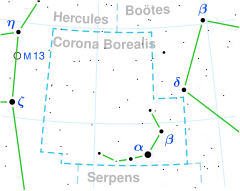
| |
| Observation data Epoch J2000 Equinox | |
|---|---|
| Constellation | Corona Borealis |
| Right ascension | 15 55 47.58774 |
| Declination | +37° 56′ 49.0397″ |
| Apparent magnitude (V) | 5.43 |
| Characteristics | |
| Spectral type | F2 IV-V |
| U−B color index | +0.01 |
| B−V color index | +0.352±0.004 |
| Astrometry | |
| Radial velocity (Rv) | −11.6±0.8 km/s |
| Proper motion (μ) | RA: 29.099 mas/yr Dec.: 79.528 mas/yr |
| Parallax (π) | 24.0631 ± 0.0890 mas |
| Distance | 135.5 ± 0.5 ly (41.6 ± 0.2 pc) |
| Absolute magnitude (MV) | +2.34 |
| Details | |
| Mass | 1.60±0.02 M☉ |
| Radius | 2.13+0.13 −0.02 R☉ |
| Luminosity | 9.382±0.046 L☉ |
| Surface gravity (log g) | 4.05±0.02 cgs |
| Temperature | 6,991±63 K |
| Metallicity | 0.00±0.05 dex |
| Rotational velocity (v sin i) | 75.7±3.8 km/s |
| Age | 1.42+0.08 −0.20 Gyr |
| Other designations | |
| λ CrB, 12 Coronae Borealis, FK5 3259, GJ 9531, HD 142908, HIP 78012, HR 5936, WDS J15558+3757A | |
| Database references | |
| SIMBAD | data |
Lambda Coronae Borealis, its name Latinised from λ Coronae Borealis, is a single star in the northern constellation of Corona Borealis. In publications it is also identified as HR 5936 and HD 142908. It has a yellow-white hue and is dimly visible to the naked eye with an apparent visual magnitude of 5.43. The star is located at a distance of 136 light years based on parallax, but is drifting closer with a radial velocity of −12 km/s.
The stellar classification of Lambda Coronae Borealis is F2 IV-V, which means it is somewhat hotter than the sun and shows spectral features intermediate between a main sequence and subgiant star. It has an estimated age of 1.4 billion years with a relatively high projected rotational velocity of 76 km/s. The star has 1.6 times the mass of the Sun and 2.1 times the Sun's radius. Based on the amount of iron in the atmosphere, the elemental abundances are similar to those in the Sun. It is radiating 9.4 times the luminosity of the Sun from its photosphere at an effective temperature of 6,991 K.
The star displays an infrared excess with a signature that indicates a pair of circumstellar disks of dusty debris are orbiting the star. A blackbody fit to the higher temperature signal gives a temperature of 320 K with an orbital distance of 2.20 AU. The cooler outer disk is orbiting 144.07 AU from the star with a temperature of 40 K.
A magnitude 11.44 visual companion was discovered by W. Herschel in 1782. As of 2015, it was located at an angular separation of 90.6″ from the brighter component, along a position angle of 68°.
References
- ^ Brown, A. G. A.; et al. (Gaia collaboration) (August 2018). "Gaia Data Release 2: Summary of the contents and survey properties". Astronomy & Astrophysics. 616. A1. arXiv:1804.09365. Bibcode:2018A&A...616A...1G. doi:10.1051/0004-6361/201833051. Gaia DR2 record for this source at VizieR.
- ^ Anderson, E.; Francis, Ch. (2012). "XHIP: An extended hipparcos compilation". Astronomy Letters. 38 (5): 331. arXiv:1108.4971. Bibcode:2012AstL...38..331A. doi:10.1134/S1063773712050015. S2CID 119257644.
- ^ Gray, R. O.; et al. (2001). "The Physical Basis of Luminosity Classification in the Late A-, F-, and Early G-Type Stars. II. Basic Parameters of Program Stars and the Role of Microturbulence". The Astronomical Journal. 121 (4): 2159. Bibcode:2001AJ....121.2159G. doi:10.1086/319957.
- Mermilliod, J.-C. (1986). "Compilation of Eggen's UBV data, transformed to UBV (unpublished)". Catalogue of Eggen's UBV Data. Bibcode:1986EgUBV........0M.
- ^ Gontcharov, G. A. (2006). "Pulkovo Compilation of Radial Velocities for 35 495 Hipparcos stars in a common system". Astronomy Letters. 32 (11): 759–771. arXiv:1606.08053. Bibcode:2006AstL...32..759G. doi:10.1134/S1063773706110065. S2CID 119231169.
- Holmberg, J.; et al. (2009). "The Geneva-Copenhagen survey of the solar neighbourhood. III. Improved distances, ages, and kinematics". Astronomy and Astrophysics. 501 (3): 941. arXiv:0811.3982. Bibcode:2009A&A...501..941H. doi:10.1051/0004-6361/200811191. S2CID 118577511.
- ^ Aguilera-Gómez, Claudia; et al. (June 2018). "Lithium abundance patterns of late-F stars: an in-depth analysis of the lithium desert". Astronomy & Astrophysics. 614: 15. arXiv:1803.05922. Bibcode:2018A&A...614A..55A. doi:10.1051/0004-6361/201732209. S2CID 62799777. A55.
- ^ Ammler-von Eiff, Matthias; Reiners, Ansgar (June 2012), "New measurements of rotation and differential rotation in A-F stars: are there two populations of differentially rotating stars?", Astronomy & Astrophysics, 542: A116, arXiv:1204.2459, Bibcode:2012A&A...542A.116A, doi:10.1051/0004-6361/201118724, S2CID 53666672.
- "lam CrB". SIMBAD. Centre de données astronomiques de Strasbourg. Retrieved 2021-01-31.
- Eggleton, P. P.; Tokovinin, A. A. (September 2008). "A catalogue of multiplicity among bright stellar systems". Monthly Notices of the Royal Astronomical Society. 389 (2): 869–879. arXiv:0806.2878. Bibcode:2008MNRAS.389..869E. doi:10.1111/j.1365-2966.2008.13596.x. S2CID 14878976.
- Cotten, Tara H.; Song, Inseok (July 2016). "A Comprehensive Census of Nearby Infrared Excess Stars". The Astrophysical Journal Supplement Series. 225 (1): 24. arXiv:1606.01134. Bibcode:2016ApJS..225...15C. doi:10.3847/0067-0049/225/1/15. S2CID 118438871. 15.
- Mason, B. D.; et al. (2014). "The Washington Visual Double Star Catalog". The Astronomical Journal. 122 (6): 3466. Bibcode:2001AJ....122.3466M. doi:10.1086/323920.
| Constellation of Corona Borealis | |||||||||||
|---|---|---|---|---|---|---|---|---|---|---|---|
| Stars |
| ||||||||||
| Exoplanets |
| ||||||||||
| Galaxies |
| ||||||||||
| Galaxy clusters |
| ||||||||||